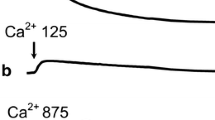Summary
Since cAMP has recently been reported to be a possible physiological modulator of cell-to-cell communication, we performed a quantitative freeze-fracture investigation on the hepatocyte gap junctions after administration of a membrane-permeant derivative of this cyclic nucleotide. For this purpose, male rats received two intraperitoneal injections of 100 mg dibutyryl cAMP/kg body weight with a time interval of 2.5 h. Litter mates were injected with saline only. Five hours after the start of the treatment, tissue blocks of the left lateral liver lobe were fixed by immersion and processed for freeze-fracture. By point counting on negatives projected on a square double-lattice test system the relative gap junctional area on contiguous hepatocyte membranes was determined. As compared to control animals, the proportion of the membrane area occupied by gap junctions in dibutyryl cAMP-treated liver parenchyma significantly increased from 4.9% to 6.1%. Within the gap junctions no changes in shape, particle density or packing pattern were observed. Possibly, the enlarged gap junctional area provides structural pathways for the integration of the response of hepatocytes to messages mediated by cAMP.
Similar content being viewed by others
References
Azarnia R, Dabl G, Loewenstein WR (1981) Cell junction and cyclic AMP: III. Promotion of junctional membrane permeability and junctional membrane particles in a junction-deficient cell type. J Membr Biol 63:133–146
Blalock JE, Stanton JD (1980) Common pathways of interferon and hormonal action. Nature (London) 283:406–408
De Mello WC (1984) Effect of intracellular injection of cAMP on the electrical coupling of mammalian cardiac cells. Biochem Biophys Res Comm 119:1001–1007
Drummond GI, Hemmings S, Warneboldt RB (1974) Uptake and catabolism of N6,2′-O-dibutyryl cyclic AMP by the perfused heart. Life Sci 15:319–328
Flagg-Newton JL, Loewenstein WR (1981) Cell junction and cyclic AMP: II. Modulations of junctional membrane permeability, dependent on serum and cell density. J Membr Biol 63:123–131
Flagg-Newton JL, Dahl G, Loewenstein WR (1981) Cell junction and cyclic AMP: I. Upregulation of junctional membrane permeability and junctional membrane particles by administration of cyclic nucleotide or phosphodiesterase inhibitor. J Membr Biol 63:105–121
Friend DS, Gilula NB (1972) Variations in tight and gap junctions in mammalian tissues. J Cell Biol 53:758–776
Garfield RE, Merrett D, Grover AK (1980) Gap junction formation and regulation in myometrium. Am J Physiol 239:C217-C228
Gros DB, Nicholson BJ, Revel J-P (1983) Comparative analysis of the gap junction protein from rat heart and liver: is there a tissue specificity of gap junctions? Cell 35:539–549
Hax WMA, van Venrooy GEPM, Vossenberg JBJ (1974) Cell communication: a cyclic-AMP mediated phenomenon. J Membr Biol 19:253–266
Henion WF, Sutherland EW, Posternak Th (1967) Effects of derivatives of adenosine 3′,5′-phosphate on liver slices and intact animals. Biochim Biophys Acta 148:106–113
Hertzberg EL, Gilula NB (1982) Liver gap junctions and lens fiber junctions: comparative analysis and calmodulin interaction. Cold Spring Harbor Symp Quant Biol 46:639–646
Johnson R, Hammer M, Sheridan J, Revel J-P (1974) Gap junction formation between reaggregated Novikoff hepatoma cells. Proc Natl Acad Sci USA 71:4536–4540
Kohen E, Kohen C, Hirschberg JG, Wouters AW, Bartick PR, Thorell B, Bereiter-Hahn J, Meda P, Rabinovitch A, Mintz D, Ploem JS (1982) Examination of single cells by microspectrophotometry and microspectrofluorometry. In: Baker PF (ed) Techniques in cellular physiology. Elsevier/North Holland Scientific Publishers Ltd, Amsterdam, pp 103/1–103/28
Lawrence TS, Beers WH, Gilula NB (1978) Transmission of hormonal stimulation by cell-to-cell communication. Nature 272:501–506
Loewenstein WR (1981) Junctional intercellular communication: the cell-to-cell membrane channel. Physiol Rev 61:829–913
MacManus JP, Franks DJ, Youdale T, Braceland BM (1972) Increases in rat liver cyclic AMP concentrations prior to the initiation of DNA synthesis following partial hepatectomy or hormone infusion. Biochem Biophys Res Comm 49:1201–1207
MacManus JP, Braceland BM, Youdale T, Whitfield JF (1973) Adrenergic antagonists, and a possible link between the increase in cyclic adenosine 3′,5′-monophosphate and DNA synthesis during liver regeneration. J Cell Physiol 82:157–164
Metz J, Bressler D (1979) Reformation of gap and tight junctions in regenerating liver after cholestasis. Cell Tissue Res 199:257–270
Meyer DJ, Yancey SB, Revel J-P (1981) Intercellular communication in normal and regenerating rat liver: a quantitative analysis. J Cell Biol 91:505–523
Penn RD (1966) Ionic communication between liver cells. J Cell Biol 29:171–174
Revel J-P, Yancey SB, Meyer DJ, Finbow M (1980) Behaviour of gap junctions during liver regeneration. In: Popper H, Bianchi L, Gudat F, Reutter W (eds) Communications of liver cells. MTP Press Ltd., Falcon House, Lancaster, England, pp 167–176
Robenek H, Rassat J, Themann H (1981) A quantitative freezefracture analysis of gap and tight junctions in the normal and cholestatic human liver. Virchows Arch (Cell Pathol) 38:39–56
Schneider-Picard G, Carpentier J-L, Girardier L (1984) Quantitative evaluation of gap junctions in rat brown adipose tissue after cold acclimation. J Membr Biol 78:85–89
Sheridan JD (1978) Junction formation and experimental modification. In: Feldman J, Gilula NB, Pitts JP (eds) Receptors and recognition. Series B, vol 2. Intercellular junctions and synapses. Chapman & Hall Ltd, London, pp 37–59
Sheridan JD, Hammer MG, Johnson RG (1975) Cyclic nucleotideinduced changes in formation of low-resistance junctions. J Cell Biol 67:395a (Abstract)
Tsien RW, Weingart R (1976) Inotropic effect of cyclic AMP in calf ventricular muscle studied by a cut end method. J Physiol 260:117–141
Wojtczak J (1982) Influence of cyclic nucleotides on the internal longitudinal resistance and contractures in the normal and hypoxic mammalian cardiac muscle. J Mol Cell Cardiol 14:259–265
Yancey SB, Dewees P, Revel J-P (1980) In vivo incorporation of 35S-methionine into gap Junctional proteins. J Cell Biol 87:212a (Abstract)
Yee AG, Revel J-P (1978) Loss and reappearance of gap junctions in regenerating liver. J Cell Biol 78:554–564
Author information
Authors and Affiliations
Additional information
This investigation was supported by grant nr. 3.0059.81 (to D.W.S.) from the Fund for Medical Scientific Research (Belgium).
Research assistant of the National Fund for Scientific Research (Belgium).
Rights and permissions
About this article
Cite this article
De Mazière, A.M.G.L., Scheuermann, D.W. Increased gap junctional area in the rat liver after administration of dibutyryl cAMP. Cell Tissue Res. 239, 651–655 (1985). https://doi.org/10.1007/BF00219244
Accepted:
Issue Date:
DOI: https://doi.org/10.1007/BF00219244




